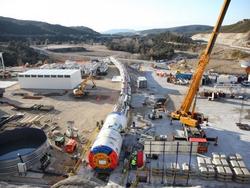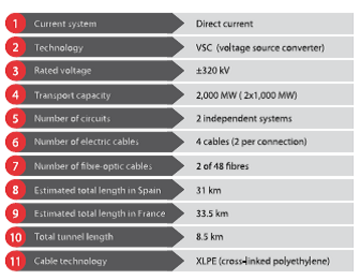
Baixas-Santa Llogaia HVDC link: doubling the interconnection capacity between France and Spain
Mar 6, 2013 - cigre.org
The whole project has been financed through the European Energy Program for recovery subsidy (European commission)

The Baixas-Santa Llogaia electrical interconnection between Spain and France is a project which presents exceptional characteristics :
- It will be the first in the world for 2x1000MW VSC converter stations
- It will be the first in the world for a DC XLPE cable at 320kV
- It has been the first time that a joint TSO company (RTE-REE) has been created to implement such a project (since then, other companies have followed this example)
- It will be the first time that such a powerful line is built fully undergrounded (64,5 km), including a dedicated 8.5km long tunnel.
- It will lead to manage a DC interconnector embedded in an AC grid
This project is born after more than 30 years of discussions between France and Spain, and after many projects have been rejected. In 2006, both French and Spanish governments asked the European Commission to nominate a coordinator in order to help them to solve the issue of the route between France and Spain. The project’s mediator, former European commissioner Mario Monti, concluded that a new interconnection line should be completely undergrounded in order to prevent environmental impact. This factor has marked the design of the entire connection, using direct current technology. Furthermore, in accordance with Mr. Monti’s recommendations, the layout follows as far as possible the existing infrastructures.
An agreement has been signed on the 27th of June 2008 in Zaragossa between the French and Spanish governments
The line will have an overall length of 64.5 kilometres (31 kilometres in Spain and 33.5 kilometres in France) in trenches.Within this length,an 8.5-kilometre tunnelwhich will parallel the high-speed train has already been built to cross the Alberas massif in the Pyrenees Mountains.
The works have begun during the last quarter 2011, with the civil works of the substations and the preparation of the entrances of the tunnel. In 2012, the tunnel has been dug and the works on the substations have continued. The first trenches have been done in France and drillings have been implemented in Spain and France. In 2013, after the end of the digging of the tunnel (april 2013) the works consist in finishing inside installations in the tunnel. For the substations, the installation of all electric materials and especially the power modules in both converter stations is currently done, as well as the installation of the transformers. The civil works: trenches and drillings are implemented in France and Spain. The first laying of cables has been initiated on the French part. This will be done on both sides (France and Spain) during the rest of the year. The connection will become operational by end 2014, thereby assuring an increase in the electrical grid’s security and the quality of supply for both countries.
Concerning the environmental issues in Spain, in order to verify compliance with the measures set forth in the Environmental Impact Study, an Environmental Monitoring Program has been designed, including a follow-up committee created with the Autonomous Government of Catalonia’s Environmental Department and Energy, Mines and Industrial Safety Bureau. Environmental measures planned in France are mainly related to the protected species protection, the conservation of existing water courses, landscape integration and restoration of land after the work. These actions were agreed with the related administrations, the mayors, associations and public utilities and are supervised several times a year by a monitoring committee.
The whole project has been financed through the European Energy Program for recovery subsidy (European commission) for an amount of 225 million euros, as well as a loan of the European Investment bank, for an amount of 350 million euros. The rest of the budget is financed by both RTE and REE.
The new ±320 kV line will allow doubling the current interconnection capacity up to 2800MW. It will result in increased security of supply and greater stability of the Iberian grid. It will also result in a better integration of the Iberian market into the European electricity market, facilitating the exchange of energy from renewable sources towards the European grid.
The new link will also create new stakes of coordination for both TSOs, RTE and REE, for the operation of the DC link in parallel of a alternative current grid. The TSOs also discuss the control and regulations of the link with the constructor.
The project company INELFE
Inelfe (France-Spain Electrical Interconnection) is a mixed-capital corporation. It was legally established on 1 October 2008, as a consequence of the signature of the Zaragossa agreement between both French and Spanish governments. INELFE is jointly-owned in equal shares by the TSOs, REE (Red Eléctrica de España) and RTE (Réseau de Transport d’Électricité). Its corporate purpose is to make the projected new electrical interconnection between both countries a reality. Inelfe is a corporation with a simplified share structure; it is governed by French law.
General features


The different interconnection lines between France and Spain

| 




